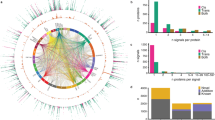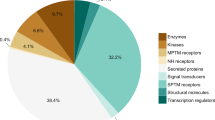Abstract
Changes in protein glycosylation are clinically used as biomarkers. In the present study, we employed a twin cohort to investigate the contributions of genetic and environmental factors to glycan modifications of glycoproteins. Mac-2 binding protein (Mac-2 bp), haptoglobin (Hp), and their glycosylated forms are liver fibrosis and cancer biomarkers. Sera from 107 twin pairs without clinical information were used as a training cohort for the Mac-2 bp and Mac-2 bp glycosylation isomer (M2BPGi) assay. As a validation cohort, 22 twin pairs were enrolled in the study. For each twin pair, one twin was diagnosed with liver or pancreatic disease. For the training cohort, the correlation ratios of serum Mac-2 bp and M2BPGi levels in twin sera with random sequences were 0.30 and 0.018, respectively. The correlation ratios between twin pairs in the validation cohort for serum Mac-2 bp and M2BPGi levels were 0.75 and 0.35, respectively. In contrast, correlation ratios of serum Hp and fucosylated haptoglobin (Fuc-Hp) levels between twin sera with liver and pancreatic disease were 0.49 and 0.16, respectively. Although serum protein levels of glycoproteins are susceptible to genetic factors, characteristic glycan changes of these glycoproteins are more susceptible to environmental factors, including liver and pancreatic disease.
Graphical abstract





Similar content being viewed by others
Abbreviations
- ELISA:
-
Enzyme-linked immunosorbent assay
- Hp:
-
Haptoglobin
- Fuc-Hp:
-
Fucosylated haptoglobin
- Mac-2 bp:
-
Mac-2 binding protein
- M2BPGi:
-
Mac-2 binding protein glycosylation isomer
References
Pinho, S.S., Reis, C.A.: Glycosylation in cancer: mechanisms and clinical implications. Nat. Rev. Cancer 15(9), 540–555 (2015). https://doi.org/10.1038/nrc3982
Miyoshi, E., Kamada, Y., Suzuki, T.: Functional glycomics: application to medical science and hepatology. Hepatol. Res.: Off. J. Jpn. Soc. Hepatol (2019). https://doi.org/10.1111/hepr.13459
Miyoshi, E., Moriwaki, K., Nakagawa, T.: Biological function of fucosylation in cancer biology. J. BioChem 143(6), 725–729 (2008). https://doi.org/10.1093/jb/mvn011
Taketa, K.: Alpha-fetoprotein: reevaluation in hepatology. Hepatology (Baltim., Md.) 12(6), 1420–1432 (1990)
Okuyama, N., Ide, Y., Nakano, M., Nakagawa, T., Yamanaka, K., Moriwaki, K., Murata, K., Ohigashi, H., Yokoyama, S., Eguchi, H., Ishikawa, O., Ito, T., Kato, M., Kasahara, A., Kawano, S., Gu, J., Taniguchi, N., Miyoshi, E.: Fucosylated haptoglobin is a novel marker for pancreatic cancer: a detailed analysis of the oligosaccharide structure and a possible mechanism for fucosylation. Int. J. Cancer 118(11), 2803–2808 (2006). https://doi.org/10.1002/ijc.21728
Matsumoto, H., Shinzaki, S., Narisada, M., Kawamoto, S., Kuwamoto, K., Moriwaki, K., Kanke, F., Satomura, S., Kumada, T., Miyoshi, E.: Clinical application of a lectin-antibody ELISA to measure fucosylated haptoglobin in sera of patients with pancreatic cancer. Clin. Chem. Lab. Med 48(4), 505–512 (2010). https://doi.org/10.1515/CCLM.2010.095
Kamada, Y., Akita, M., Takeda, Y., Yamada, S., Fujii, H., Sawai, Y., Doi, Y., Asazawa, H., Nakayama, K., Mizutani, K., Fujii, H., Yakushijin, T., Miyazaki, M., Ezaki, H., Hiramatsu, N., Yoshida, Y., Kiso, S., Imai, Y., Kawada, N., Takehara, T., Miyoshi, E.: Serum fucosylated Haptoglobin as a Novel Diagnostic Biomarker for Predicting hepatocyte ballooning and nonalcoholic steatohepatitis. PloS one. 8(6), e66328 (2013). https://doi.org/10.1371/journal.pone.0066328
Miyoshi, E., Kamada, Y.: Application of glycoscience to the early detection of pancreatic cancer. Cancer Sci 107(10), 1357–1362 (2016). https://doi.org/10.1111/cas.13011
Kamada, Y., Fujii, H., Fujii, H., Sawai, Y., Doi, Y., Uozumi, N., Mizutani, K., Akita, M., Sato, M., Kida, S., Kinoshita, N., Maruyama, N., Yakushijin, T., Miyazaki, M., Ezaki, H., Hiramatsu, N., Yoshida, Y., Kiso, S., Imai, Y., Kawada, N., Takehara, T., Miyoshi, E.: Serum Mac-2 binding protein levels as a novel diagnostic biomarker for prediction of disease severity and nonalcoholic steatohepatitis. Proteom. Clin. Appl. 7(9–10), 648–656 (2013). https://doi.org/10.1002/prca.201200137
Artini, M., Natoli, C., Tinari, N., Costanzo, A., Marinelli, R., Balsano, C., Porcari, P., Angelucci, D., D’Egidio, M., Levrero, M., Iacobelli, S.: Elevated serum levels of 90K/MAC-2 BP predict unresponsiveness to alpha-interferon therapy in chronic HCV hepatitis patients. J. Hepatol 25(2), 212–217 (1996)
Kuno, A., Ikehara, Y., Tanaka, Y., Ito, K., Matsuda, A., Sekiya, S., Hige, S., Sakamoto, M., Kage, M., Mizokami, M., Narimatsu, H.: A serum “sweet-doughnut” protein facilitates fibrosis evaluation and therapy assessment in patients with viral hepatitis. Sci. Rep 3, 1065 (2013). https://doi.org/10.1038/srep01065
Shirabe, K., Bekki, Y., Gantumur, D., Araki, K., Ishii, N., Kuno, A., Narimatsu, H., Mizokami, M.: Mac-2 binding protein glycan isomer (M2BPGi) is a new serum biomarker for assessing liver fibrosis: more than a biomarker of liver fibrosis. J. Gastroenterol 53(7), 819–826 (2018). https://doi.org/10.1007/s00535-017-1425-z
Kamada, Y., Ono, M., Hyogo, H., Fujii, H., Sumida, Y., Yamada, M., Mori, K., Tanaka, S., Maekawa, T., Ebisutani, Y., Yamamoto, A., Takamatsu, S., Yoneda, M., Kawada, N., Chayama, K., Saibara, T., Takehara, T., Miyoshi, E.: Use of Mac-2 binding protein as a biomarker for nonalcoholic fatty liver disease diagnosis. Hepatol. Commun 1(8), 780–791 (2017). https://doi.org/10.1002/hep4.1080
Kamada, Y., Ono, M., Hyogo, H., Fujii, H., Sumida, Y., Mori, K., Tanaka, S., Yamada, M., Akita, M., Mizutani, K., Fujii, H., Yamamoto, A., Takamatsu, S., Yoshida, Y., Itoh, Y., Kawada, N., Chayama, K., Saibara, T., Takehara, T., Miyoshi, E.: A novel noninvasive diagnostic method for nonalcoholic steatohepatitis using two glycobiomarkers. Hepatology (Baltim., Md.) 62(5), 1433–1443 (2015). https://doi.org/10.1002/hep.28002
Hayakawa, K.: [Importance of twin research in preventive medicine and future perspective. Gene-environment interaction research in epigenetics era]. Nihon eiseigaku zasshi. Jpn. J. Hyg 66(1), 29–30 (2011). https://doi.org/10.1265/jjh.66.29
Hayakawa, K., Iwatani, Y.: An overview of multidisciplinary research resources at the Osaka University Center for Twin Research. Twin Res. Hum. Genet.: Off. J. Int. Soc. Twin Stud 16(1), 217–220 (2013). https://doi.org/10.1017/thg.2012.141
Kamada, Y., Kinoshita, N., Tsuchiya, Y., Kobayashi, K., Fujii, H., Terao, N., Kamihagi, K., Koyama, N., Yamada, S., Daigo, Y., Nakamura, Y., Taniguchi, N., Miyoshi, E.: Reevaluation of a lectin antibody ELISA kit for measuring fucosylated haptoglobin in various conditions. Clin. Chim. Acta 417, 48–53 (2013). https://doi.org/10.1016/j.cca.2012.12.014
van der Straten, A., Herzog, A., Cabezón, T., Bollen, A.: Characterization of human haptoglobin cDNAs coding for alpha 2FS beta and alpha 1S beta variants. FEBS Lett 168(1), 103–107 (1984). https://doi.org/10.1016/0014-5793(84)80215-x
Koths, K., Taylor, E., Halenbeck, R., Casipit, C., Wang, A.: Cloning and characterization of a human Mac-2-binding protein, a new member of the superfamily defined by the macrophage scavenger receptor cysteine-rich domain. J. Biol. Chem 268(19), 14245–14249 (1993)
Morishita, K., Ito, N., Koda, S., Maeda, M., Nakayama, K., Yoshida, K., Takamatsu, S., Yamada, M., Eguchi, H., Kamada, Y.: Haptoglobin phenotype is a critical factor in the use of fucosylated haptoglobin for pancreatic cancer diagnosis. Clin. Chim. Acta 487, 84–89 (2018)
Langlois, M.R., Delanghe, J.R.: Biological and clinical significance of haptoglobin polymorphism in humans. Clin. Chem 42(10), 1589–1600 (1996)
Acknowledgements
We would like to thank the master course students for assaying for the biomarkers. We also thank Mr. Yudai Uenoyama at Sysmex Corporation for his support in performing the M2BPGi assay. The authors are also thankful to Beckman Coulter, Inc. (Tokyo, JAPAN) for the collaborative work.
Funding
Supported by the Ministry of Education, Culture, Sports, Science and Technology of Japan (number 19H03562, 22H02967) and by a collaboration grant with Sysmex Corporation (number J770701645). This work was also supported by University Grants from the Japanese Ministry of Education, Culture, Sports, Science and Technology.
Author information
Authors and Affiliations
Consortia
Corresponding author
Ethics declarations
Conflict of interest
We have a collaborative grant with Sysmex Corporation.
Ethical approval
The ethical committee at Osaka University Hospital approved the study protocol (protocol IDs 696 and 19389).
Additional information
Publisher’s Note
Springer Nature remains neutral with regard to jurisdictional claims in published maps and institutional affiliations.
Supplementary information
Below is the link to the electronic supplementary material.
10719_2023_10099_MOESM1_ESM.docx
Supplementary Fig. 1 Correlation of Mac-2 bp and M2BPGi in the training cohort. A and B Comparison of serum (A) Mac-2 bp levels and (B) M2BPGi levels of each of the 107 twin pairs using random change correlation method (method 1). C and D Comparison of serum (C) Mac-2 bp levels and (D) M2BPGi levels of each of the 107 twin pairs using comparative method of high score on the Y-axis and the low score on the X-axis (method 2) (DOCX 54 KB)
10719_2023_10099_MOESM2_ESM.docx
Supplementary Fig. 2 Correlation of Mac-2 bp and M2BPGi in the training cohort, not including cases with high Mac-2 bp expression (M2BPGi > 3.0 or Mac-2 bp > 6.0 µg/ml). A and B Comparison of serum (A) Mac-2 bp levels and (B) M2BPGi levels of each of the 102 twin pairs not including cases with high Mac-2 bp expression using random change correlation method (method 1). C and D Comparison of serum (C) Mac-2 bp levels and (D) M2BPGi levels of each of the 102 twin pairs not including cases with high Mac-2 bp expression using comparative method of high score on the Y-axis and the low score on the X-axis (method 2). (DOCX 59 KB)
Rights and permissions
Springer Nature or its licensor (e.g. a society or other partner) holds exclusive rights to this article under a publishing agreement with the author(s) or other rightsholder(s); author self-archiving of the accepted manuscript version of this article is solely governed by the terms of such publishing agreement and applicable law.
About this article
Cite this article
Asuka, T., Kamada, Y., Morishita, K. et al. Twin research shows glycan changes are more susceptible to environmental factors than their carrier glycoproteins. Glycoconj J 40, 191–198 (2023). https://doi.org/10.1007/s10719-023-10099-7
Received:
Revised:
Accepted:
Published:
Issue Date:
DOI: https://doi.org/10.1007/s10719-023-10099-7




